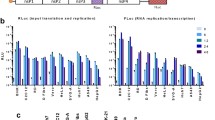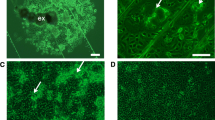Abstract
Chikungunya virus (CHIKV) is a mosquito-borne alphavirus that transmits in between a mosquito host vector to a primate host and then back to the mosquito host vector to complete its life cycle. Hence, CHIKV must be able to replicate in both host cellular systems that are genetically and biochemically distinct. The ability to grow and propagate the virus in high titers in the laboratory is fundamentally crucial in order to understand virus replication in different host cellular systems and many other CHIKV research areas. Here, we describe a method on CHIKV propagation using C6/36, a mosquito cell line derived from Aedes albopictus in both serum-containing and serum-free media.
Access this chapter
Tax calculation will be finalised at checkout
Purchases are for personal use only
Similar content being viewed by others
References
Khan AH, Morita K, Parquet Md Mdel C, Hasebe F, Mathenge EG, Igarashi A (2002) Complete nucleotide sequence of chikungunya virus and evidence for an internal polyadenylation site. J Gen Virol 83:3075–3084
Solignat M, Gay B, Higgs S, Briant L, Devaux C (2009) Replication cycle of chikungunya: a re-emerging arbovirus. Virology 393:183–197
McIntosh BM, Jupp PG, dos Santos I (1977) Rural epidemic of chikungunya in South Africa with involvement of Aedes (Diceromyia) furcifer (Edwards) and baboons. S Afr J Sci 73:267–269
Pulmanausahakul R, Roytrakul S, Auewarakul P, Smith DR (2011) Chikungu-nya in Southeast Asia: understanding the emergence and finding solutions. Int J Infect Dis 15:671–676
Weaver SC, Forrester NL (2015) Chikungunya: evolutionary history and recent epidemic spread. Antiviral Res 120:32–39
Wikan N, Sakoonwatanyoo P, Ubol S, Yoksan S, Smith DR (2012) Chikungunya virus infection of cell lines: analysis of the East, Central and South African Lineage. PLos One 7(1):e31102
Her Z, Malleret B, Chan M, Ong EK, Wong SC, Kwek DJ, Tolou H, Lin RT, Tambyah PA, Renia L, Ng LF (2010) Active infection of human blood monocytes by chikungunya virus triggers an innate immune response. J Immunol 184:5903–5913
Myles KM, Wiley MR, Morazzani EM, Adelman ZN (2008) Alphavirus-derived small RNAs modulate pathogenesis in disease vector mosquitoes. Proc Nat Acad Sci 105:19938–19943
Myles KM, Morazzani EM, Adelman ZN (2009) Origins of alphavirus-derived small RNAs in mosquitoes. RNA Biol 6:387–391
Desmyter J, Melnick JL, Rawls WE (1968) Defectiveness of interferon production and of rubella virus interference in a line of African Green Monkey kidney cells (Vero). J Virol 2:955–961
Brackney DE, Scott JC, Sagawa F, Woodward JE, Miller NA, Schilkey FD, Mudge J, Wilusz J, Olson KE, Blair CD, Ebel GD (2010) C6/36 Aedes albopictus cells have a dysfunctional antiviral RNA interference response. PLoS Neglect Trop Dis 4(10):e856
Scott JC, Brackney DE, Campbell CL, Bondu-Hawkins V, Hjelle B, Ebel GD, Olson KE, Blair CD (2010) Comparison of dengue virus type-2-specific smalls from RNA interference-competent and –incompetent mosquito cells. PLoS Negl Trop Dis 4(10):e848
Li YG, Siripanyaphinyo U, Tumkosit U, Noranate N, A-nuegoonpipat A, Tao R, Kurosu T, Ikuta K, Takeda N, Anantapreecha S (2013) Chikungunya virus induces a more moderate cytopathic effect in mosquito cells than in mammalian cells. Intervirology 56(1):6–12
Morris CB (2007) Cryopreservation of animal and human cell lines. In: Day JG, Stacey GN (eds) Cryopreservation and freeze-drying protocols, methods in molecular biology, vol 368. Humana Press, Totowa, NJ, pp 227–236
Richardson A, Fedoroff S (2009) Tissue culture procedures and tips. In: Doering LC (ed) Protocols for neural cell culture, Springer protocols handbooks. Humana Press, Totowa, NJ, pp 375–390
Morita K, Igarashi A (1989) Suspension culture of Aedes albopictus cells for Flavivirus mass production. J Tissue Cult Meth 12(3):35–36
Tripathi NK, Shrivastava A, Dash PK, Jana AM (2011) Detection of dengue virus. In: Stephenson JR, Warnes A (eds) Diagnostic virology protocols, methods in molecular biology, vol 665. Humana Press, Totowa, NJ, pp 51–64
Author information
Authors and Affiliations
Corresponding author
Editor information
Editors and Affiliations
Rights and permissions
Copyright information
© 2016 Springer Science+Business Media New York
About this protocol
Cite this protocol
Ang, S.K., Lam, S., Chu, J.J.H. (2016). Propagation of Chikungunya Virus Using Mosquito Cells. In: Chu, J., Ang, S. (eds) Chikungunya Virus. Methods in Molecular Biology, vol 1426. Humana Press, New York, NY. https://doi.org/10.1007/978-1-4939-3618-2_8
Download citation
DOI: https://doi.org/10.1007/978-1-4939-3618-2_8
Published:
Publisher Name: Humana Press, New York, NY
Print ISBN: 978-1-4939-3616-8
Online ISBN: 978-1-4939-3618-2
eBook Packages: Springer Protocols




